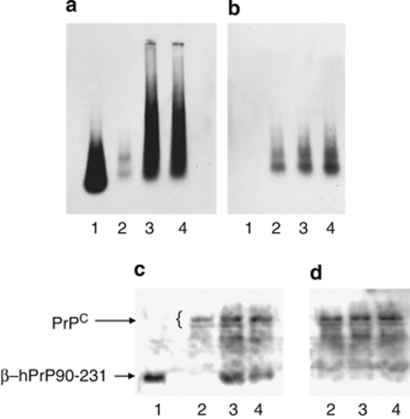Figure 3.
Internalized β–hPrP90-231 forms SDS-stable aggregates. Cells were treated with vehicle (lanes 2 a–d) or β–hPrP90-231 (1 μM) for 1 (lanes 3 a–d) and 4 days (lanes 4 a–d). Total cell lysates (100 μg) were resolved by semi-denaturing detergent-agarose gel electrophoresis (a and b) and SDS-PAGE (c and d). Blots were probed with anti-PrP antibodies 3F4 (a and c) and 8B4 (b and d). Purified β–hPrP90-231 (100 ng, lanes 1 a–c) was subjected to both electrophoretic conditions, to evidence its apparent molecular weight (c, lane 1), and native aggregation state (a, lane 1). No signal is detected in lane 1b, as 8B4 antibody does not recognize β–hPrP90-231. Blot a shows 3F4-immunoreactive aggregates after 1 and 4 days of treatment with hPrP90-231. Blot b shows that no significant 8B4-reactive aggregates are induced by β–hPrP90-231 treatment. SDS-PAGE shows that, although β–hPrP90-231 monomer is recovered within SH-SY5Y cytoplasm after 1 and 4 days of treatment (blot c), the expression of endogenous PrPC is unmodified (blot d)

